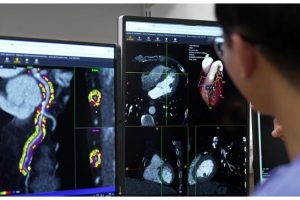When Los Angeles County officials began researching the possibility of constructing a new hospital to replace one in South LA that closed in 2007, they knew they wanted a state-of-the-art facility that would provide excellent medical care for local residents, many of whom were low-income and lacked insurance. They also wanted to give residents the ability to easily connect with providers and organizations in the community.
The old hospital had lost federal funding after failing a comprehensive review by CMS, leaving the 1.3 million residents of South LA without comprehensive medical care they could get to quickly and easily. In addition, the old hospital’s systems were antiquated, its infrastructure couldn’t support the advances taking place in health IT, and it had been beset with complaints of poor patient care.
The vision then was to create a new facility where digital technology would drive the vision of community-focused healthcare. But realizing that vision required planning, constant oversight, and adaptability, said Brad Armstrong, senior partner at T2C, and a key consultant on building the Martin Luther King, Jr. Community Hospital’s IT system.
Adding to the complexity of the project was the organization that would administer the hospital — the Martin Luther King, Jr. Los Angeles Healthcare Corporation — was also brand new. “We were in a unique public-private partnership,” said Sajid Ahmed, chief information and innovation officer at MLK. “Our venture capitalists were the community of Los Angeles County.”
Of the $158 million budget the county provided to build the hospital, nearly half — $70 million — was devoted to IT, Ahmed said.
The 131-bed comprehensive care facility opened in July 2015 with new-age capabilities such as smart beds that track patients’ movements, a patient interactive system, and care phones that allow doctors and nurses to communicate and share patient information on an internal network while remaining secured from accessing data outside the hospital.
Building the foundation
So what are some the key considerations that go into building an all-digital hospital?
First and foremost was creating a vision, said Ahmed. The hospital’s leaders knew they wanted to have fully integrated EHRs across all departments, and an integrated workflow to enhance care management. Once that was determined, the challenge was deciding what was doable with the budget they had, and what they could do without or add later.
Two things they didn’t need were a real-time location system and wireless telemetry. While both could improve efficiency, they posed challenges that could better be addressed once the hospital was operational, Ahmed said. The hospital’s staffing model called for round-the-clock intensivists, making these technologies less essential.
“We wanted to be cutting edge but not leading edge, and we wanted to be practical, too,” Ahmed said. “But we also didn’t want to be rooted in old foundations, so we went with an EHR system, we went with connectivity and we went with mobile solutions internally.”
The organization also considered future-proofing the hospital by ensuring everything that was hardwired into the hospital was as flexible as possible. This meant building infrastructure that could adapt to additional bandwidth and more advanced applications, such as wireless telemetry down the road, explained Armstrong.
Officials also wanted to beef up connections both inside and outside the hospital as much as possible, and they looked to cloud computing to get them off the ground. High availability was key, and with the cloud, hospitals — particularly smaller ones — can “leverage shared solutions and infrastructure and reduce the need to acquire and maintain scarce IT people and technologies in-house,” Armstrong said.
The ACA and the thrust toward population health also drove efforts to ensure broad connectivity. “Care coordination is our goal, and as we move more and more toward value-based payment structures, that technology backbone is very critical,” Ahmed said.
The hospital initially connected with a local independent physicians’ association and plans to soon go live on a community information exchange platform, which will enable more robust and direct data sharing. A key goal for 2016 is completing connectivity so providers can access information immediately when patients are admitted to the hospital and when they are transitioned back to ambulatory or post-acute care, Ahmed said.
Another concern for the health IT team was keeping it simple, which meant working with as few vendors as possible so that they could leverage wholesale purchasing and push for more discounts. Since MLK is not county-run, it had more flexibility to showcase vendors’ products, Ahmed noted. Costs and timelines were monitored on a weekly basis.
Overall planning for the IT system involved a series of layers and iterations, Armstrong said. There was a formal strategic planning process to determine how the IT infrastructure would be designed. That said, you can never plan enough, Ahmed said, noting planning staff IT training was one area that was overlooked early on. His team learned having a contingency plan is critical. In addition, new leadership at the hospital was being brought on board during the planning process and their wishes and input had to be considered, leading to changes.
Adding it all up
After all the hi-tech bells and whistles are in place, how do you measure return on investment?
With a brand-new hospital like MLK, that can be difficult, Armstrong said, because there’s no baseline against which to measure ROI. What T2C and MLK did was take the vision they had, decide what technologies really supported such a vision, come up with a ballpark figure to allocate for IT, and then see if they stayed within that budget, he said.
“We tried to pick technologies that were proven and high value,” Armstrong said. “So we were very accountable in making sure we stayed focused on things that really count and really moved the ball.”
Ahmed views ROI from a slightly different perspective. The true measure of return on investment in a startup hospital is engagement with the community and community response, he said, adding that seven months post-opening, both the emergency room and general hospital are at near capacity.
“That means people in the community have instantly engaged with us,” Ahmed said. “It’s a cost that gives back 10-fold to 100-fold.”
The county’s intention in investing in the project was building a successful hospital that would be used by local residents.
Because of the delay between when much of the IT was purchased and MLK’s opening, officials also managed to renegotiate with all of the vendors to provide upgraded technologies at no cost, Ahmed said. This pushed out the time to refresh systems to five years, saving the hospital money over time.
































